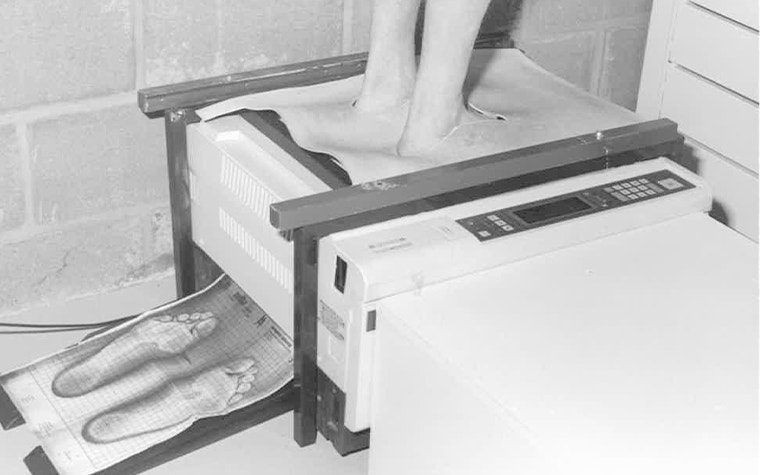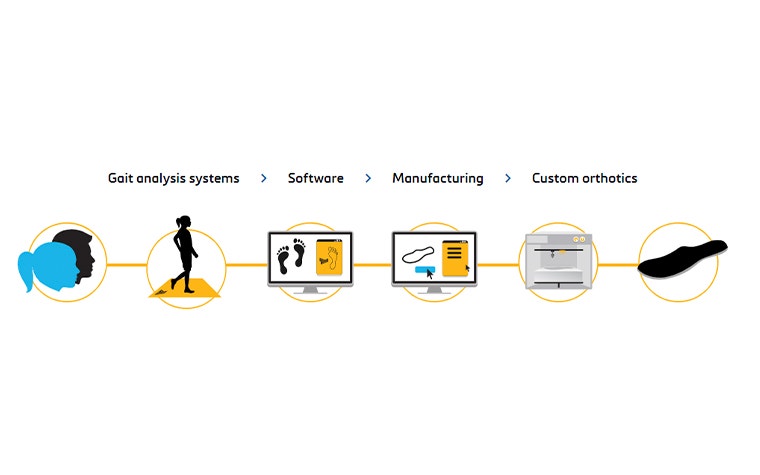EXPERT INSIGHT
When Extraordinary Ideas Come to Life: The Story behind Materialise Motion

Ideas come to people in the most unexpected ways. Sometimes, they go latent, but now and then, a visionary comes along with an entrepreneurial mind and an unthinkable idea that has the power to change the lives of many.
Over thirty years ago, Fried Vancraen, founder and CEO of Materialise, recognized the extraordinary potential of 3D printing. He was determined to make a difference in the world by harnessing the power of technology and creativity.
Another innovator with an engineering background had a similar path. The founder of RSscan, Jempi Wilssens, was an elite athlete and an electrotechnical engineer who not only transformed the world of running, but also revolutionized the design of orthotics
Throughout his active years as an athlete, Jempi often dealt with injuries. He wanted to understand how they could be avoided or minimized. Driven by his interest in orthopaedics and podiatry, Jempi started his incredible innovation journey. In 1980, he assembled a copier that could determine foot types.
As he began to explore biomechanics further, he applied his engineering skills to create a solution focusing on gait analysis. Considering our feet are in constant movement, it's more reasonable to take a dynamic scan instead of a solely static one.
In 1984, footscan came to life, which he continued to develop even further in the following years. footscan is one integrated gait analysis solution that combines dynamic pressure plate and advanced software. When a patient walks across the footscan pressure plate, highly sensitive sensors scan the foot and define pressure points. This data is generated into quantifiable measurements that are further analyzed in the software providing static and dynamic analysis, 3D visualizations, force graphs, and side-by-side comparisons. footscan offered the necessary data to create custom insoles and provided the visualization of dynamic pressure points.


After working for Adidas, Jempi acquired deep knowledge of shoe and insole design and manufacturing, making him competent and confident to start his own business. He launched Runners Service (later changed to Runners’ Lab) with a mission to provide advice and the best shoes and sportswear for runners. It was one of the first companies to start the revolution in designing shoes adjusted to each athlete’s gait and running style.
But Jempi didn’t stop there. After Runners’ Lab, he also founded RSscan International. Guided by his engineer mindset and problem-solving attitude, Jempi expanded his ideas through patented technology. RSscan offered two solutions, the world-renowned footscan software, and pressure measurement system. RSscan became an industry-frontrunner with more than 5,000 footscan users worldwide. The advanced dynamic gait measuring system and analysis software are applicable for clinical, retail, and scientific use.


Combining Expertise and Innovation in an Ambitious Vision
Jempi Willssens and Fried Vancraen have a lot in common. Humble innovators, determined founders, both based in Belgium, running successful businesses. So, it didn’t come as a surprise that RSscan and Materialise decided to join their forces in April 2014 when they launched RSPrint, a venture that combines the expertise and vision of both industry leaders.
The idea of collaboration began when RSscan wanted to improve their production of insoles. They tried to make the entire process more efficient and user-friendly. The objective was to create an end-to-end solution that would incorporate accurate analysis data, design, automation, and production processes. The digitalization also enables the possibility to reproduce insoles quickly and flawlessly.
RSscan faced quite a few challenges when first experimenting with regular 3D printers. The process was too slow, not durable, and not accurate enough.
However, all that changed once Materialise stepped into the picture. With Selective Laser Sintering, Materialise can produce completely personalized objects on a large scale. This advanced method fit perfectly with the needs of RSscan, as their goal was to create functionally customized insoles.


Led by an experienced team of biomechanics, medics, engineers, and software developers, RSPrint and Materialise developed Phits, the world’s first dynamic 3D-printed insoles, fully customized and highly scalable.
Stepping into a New Decade with Materialise Motion
In 2020, following the successful collaboration and mutual goals for the future, Materialise acquired the dynamic foot measurement technology from RSscan, and RSPrint’s Phits Insole product line. By merging RSPrint and RSscan under one name, Materialise Motion is a business line that aims to expand research and product development while widening the portfolio of services and solutions for footcare experts and their patients.
The flagship solution, Materialise Phits Suite, unifies Materialise’s 3D printing technology and RSscan’s advanced gait analysis in one comprehensive digital toolkit. Created as a three-stage workflow, it enables foot experts to design the most suitable orthotics more efficiently and accurately.
In the initial phase, Materialise Phits Suite helps foot experts scan and measure patient’s data by using high-quality footscan pressure plates and 3D scanners. Next, the footscan software automates the insole design and provides science-based recommendations with a manual expert input option. And lastly, the foot expert can send the generated insole design through a cloud portal to the Materialise production facility. Within days, custom 3D-printed orthotics are delivered to the practice, and ultimately, to the patient.

Materialise Phits Suite is an all-in-one solution assisting you through the entire process, from scan to orthotics.
Thanks to high-end measuring and scanning devices, renowned footscan software with design recommendations, and manufacturing automation, Materialise Phits Suite is the most comprehensive toolkit for foot experts.
Today over a thousand practices, labs, hospitals, and universities already enjoy the benefits of our technology. From the first prints with a photocopier to creating the footscan software and Materialise Phits Suite, 3D-printed insoles evolved into a new standard for patient care and sophisticated expert workflow.
And it all started forty years ago with an idea.
Share on:
You might also like
Never miss a story like this. Get curated content delivered straight to your inbox.
